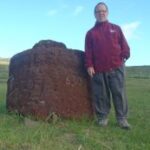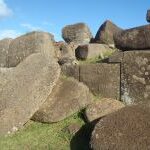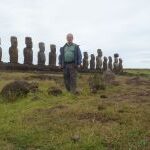May 23, 2014
Escape from the stoney faced living gods
 It was possible to escape from the Moai today, and see a different side of Rapa Nui, but to do so, I had to scale the largest volcano (there are 70 on the island) and view one of the more interesting “competitions” that distinguished the civilization that followed the stoney ones. The society that emerged from the 17th century wars focused on the life-giving birds that came to the island, bestowing eggs and meat. The migration in the spring (September) marked one of the strangest games this side of Olympus. The clans vied to capture the first egg of the year. The bravest warriors would live on the top of the caldera, then scale the 1000 foot cliff to the sea below, swim to one of three nearby islets (about half mile), capture an egg, and return with it intact by swimming the half mile and rescaling the 1000 foot cliff (it’s a sheer face). The winner, or his clan chief, got the title of “birdman,” which replaced the “living god” of the statues. “Birdman” got to live in seclusion for a year–no doubt recovering from his feat. Interestingly, the center of the volcano (about 1000 feet down) was the main source of water in dry seasons. Our guide said that islanders went down the slope to get water, bathe, and wash clothes; no doubt that prepared them for the dual meet of collecting bird’s eggs.
It was possible to escape from the Moai today, and see a different side of Rapa Nui, but to do so, I had to scale the largest volcano (there are 70 on the island) and view one of the more interesting “competitions” that distinguished the civilization that followed the stoney ones. The society that emerged from the 17th century wars focused on the life-giving birds that came to the island, bestowing eggs and meat. The migration in the spring (September) marked one of the strangest games this side of Olympus. The clans vied to capture the first egg of the year. The bravest warriors would live on the top of the caldera, then scale the 1000 foot cliff to the sea below, swim to one of three nearby islets (about half mile), capture an egg, and return with it intact by swimming the half mile and rescaling the 1000 foot cliff (it’s a sheer face). The winner, or his clan chief, got the title of “birdman,” which replaced the “living god” of the statues. “Birdman” got to live in seclusion for a year–no doubt recovering from his feat. Interestingly, the center of the volcano (about 1000 feet down) was the main source of water in dry seasons. Our guide said that islanders went down the slope to get water, bathe, and wash clothes; no doubt that prepared them for the dual meet of collecting bird’s eggs.
The afternoon we returned to the Ahu Moai, but with a difference. We 
 started at another volcano which had a red lava stone that was used for the hats on the moai, since it might have resembled the turbans or top knots the islanders wore. As with the other quarry, the warfare resulted in abandoning the stones where they lay. The huge stones (there were 40 numbered on the field) were transported 12 or 10 kilometers away to the ahus, to be placed on the moia on site.
started at another volcano which had a red lava stone that was used for the hats on the moai, since it might have resembled the turbans or top knots the islanders wore. As with the other quarry, the warfare resulted in abandoning the stones where they lay. The huge stones (there were 40 numbered on the field) were transported 12 or 10 kilometers away to the ahus, to be placed on the moia on site.
 Another visit was to a strange reconstruction of fallen moia. The main reconstruction in the early 60s placed the statues facing the land (and guarding the people), but the statues kept falling. There were seven of them, and someone figured out that these symbolically represented the founders of the island population, who apparently placed THESE statues facing Polynesia, whence they had come. At least placed facing out, they stayed upright.
Another visit was to a strange reconstruction of fallen moia. The main reconstruction in the early 60s placed the statues facing the land (and guarding the people), but the statues kept falling. There were seven of them, and someone figured out that these symbolically represented the founders of the island population, who apparently placed THESE statues facing Polynesia, whence they had come. At least placed facing out, they stayed upright.
The last stop was in a lava tube–a cave, which for many years furnished housing for the population; some had holes which let in enough light to plant gardens, but the one we stopped at gave us an idea of the power of the volcanic explosions and their results.
The group in my bus was literally thrown together from all over the world–a young man from Northbrook, one from Florida, and I represented the US; a couple from Chile went both days with me as did a lady from Brazil and a young woman from Australia. I also talked with a Swiss businessman who was here on holiday from his half-year in Paraguay. And we met a sailor from Chile who had spent 26 days at sea getting here. As you can tell by this description, this “navel of the world” is on a lot of people’s bucket list, and having been here, I can understand why.
Long day/ride tomorrow. Happy holiday.